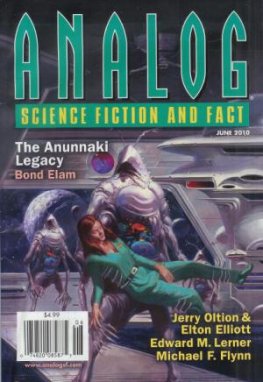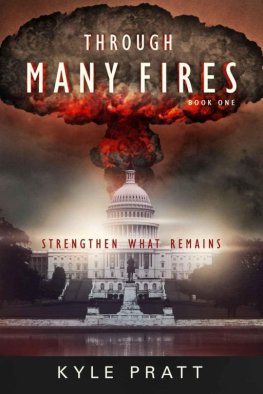Ray Gorham
77 DAYS IN SEPTEMBER
This book is dedicated to my indescribably patient, loving, devoted and helpful wife, Jodi, and our five wonderful children
Geoff, Tyler, Jessica, Nate, and Andrew.
A huge thank you also goes out to all those who have helped shape the story, the characters, and plodded through the various manuscripts as this project evolved.
I couldnt have done it without you.
On July 9, 1962, residents of the Hawaiian Islands became unwitting eyewitnesses of the latest scourge to escape from Pandoras nuclear box. At just after eight oclock in the evening, thirty electrical circuits powering a total of 300 streetlights overloaded, power lines melted together, burglar alarms sounded, dozens of car ignitions were rendered inoperable, TVs and radios malfunctioned, and microwave phone service to the island of Kauai was disrupted. At the exact same time, 930 miles southwest of Hawaii and 248 miles above sea level, the United States military detonated a 1.3-megaton nuclear bomb. The blast was an exercise by the Defense Atomic Support Agency (DASA) and the Atomic Energy Commission (AEC) to determine and measure the effects of high altitude nuclear detonations for potential military applications.
This test, nicknamed Starfish Prime, was, and still is, the highest altitude, highest yield, atmospheric nuclear test of this type ever performed. It involved a bomb measuring just 20 in diameter, 54.3 in length, and weighing a little less than 1,700 lbs. A number of phenomena were observed as a result of the blast: an aurora was formed that lasted for over seven minutes and extended from Hawaii to New Zealand; seven satellites were immediately disabled, and, within a year, one-third of all low earth-orbiting satellites would fail (including Telstar 1, the worlds first communications satellite); radiation from the blast was trapped by the earths magnetic belts for seven years; and a previously theorized, but never studied, phenomenon called an Electromagnetic Pulse (EMP) was observed, the direct cause of the problems in Hawaii.
The year 1962 saw significant nuclear testing by both the United States and the Soviet Union, the worlds two superpowers. The American tests, of which Starfish Prime was just one in a series, were conducted in response to the Soviet Unions failure to renew a nuclear test ban a year earlier. Late in 1962, during the height of the Cuban missile crisis, the Soviets performed Test 184, code named Operation K. Carried out on October 22, Operation K involved the detonation of a 300-kiloton bomb 170 miles above a sparsely populated area of Kazakhstan. As with the American test, the most eye-opening consequences of the test resulted from the EMP phenomenon, including 355 miles of overhead telephone lines being rendered useless and 620 miles of underground power cables fusing together. In addition to the destruction of the cables, the power plant that was connected to the underground power line, unable to handle the corresponding electrical surge, caught fire and burned to the ground.
As scientists studied the data recorded during the 1962 atmospheric detonations, they determined that a single nuclear bomb detonated 300 miles above Kansas would create an EMP effect that would impact the entire continental United States. Indeed, the electrical devastation from such an attack would extend north and south of Americas borders, affecting every major Canadian and Mexican city as well. The result of this would be a continent of twenty first century people forced to survive with nineteenth century technology.
Less than one year after Operation K, the United States, the Soviet Union, and the United Kingdom, the nuclear powers of that period, signed the Partial Test Ban Treaty (PTBT) which, among other things, outlawed all atmospheric nuclear testing.
Since the signing of the PTBT in 1963, our world has changed significantly. Almost extinct, except in museums and time capsules, are the hardy vacuum tubes and electronics that were the standard of the early sixties. These have been replaced by the tiny, inexpensive, and amazingly fragile microchips of our day. These microchips, the source of so much convenience in our world, are many thousands of times more vulnerable to the effects of an EMP device than anything that was in service in 1962. Combine this technical vulnerability with nuclear proliferation and our world teeming with hostile countries and terrorist groups, and it quickly becomes obvious that North America, and all modern economies, face the potential for a catastrophe of unimaginable severity.
Fast forward forty-five years from the signing of the PTBT to September 2, 2008 and an article in the Washington Times titled Invisible Nuclear Threat by Dr. William R. Graham, Chairman of The Commission to Assess the Threat to the United States from Electromagnetic Pulse (EMP) Attack. In his article, Dr. Graham laments the unwillingness of the United States to adequately address the threat posed by rogue nations and their ability to launch such an attack. Instead, he laments, the government has focused its efforts almost exclusively on a dirty bomb or conventional strike that can only be carried out by a bomb smuggled into the country. Dr. Graham writes as follows:
this other nuclear threat is potentially far more catastrophic; instead of a single city, it could threaten the entire nations survival.
Our vulnerability to EMP attack is increasing daily, as our dependence on electronics continues to grow.
One scenario of special concern is an EMP attack against the United States launched from an ordinary freighter off the U.S. coast using a short or medium range missile to loft a nuclear warhead to high altitude (such missiles are readily available on the worlds armaments black market).
While 77 Days in September takes some dramatic license, it is based on realistic assumptions and is an attempt to entertain while putting into perspective the impact such an attack would have at a national, as well as an individual and family level, should the unthinkable happen.
Ray Gorham
Friday, September 2nd
George Bush International Airport, Houston, Texas 15:40 EST
Kyle worked his way down the aisle of the airplane, squeezing past the other passengers as they struggled to jam their oversized carry-ons into already too-full overhead bins,.. Excuse me pardon me thank you, Kyle mumbled as he went by, irritated that his flight was already thirty minutes behind schedule. Kyle re-checked his boarding pass for his seat assignment, 26F, then scanned the numbers above the seats. 23 24 25. 26. A balding man in his late fifties who, by his tan face and comfortable attire, looked like hed come directly from a golf course, sat in the aisle seat, the two seats beside him empty.
Im sorry to bother you, Kyle said, making eye contact with the man and motioning to the seat by the window. I need to slip by. Im in that seat.
The man nodded and rose, and Kyle squeezed past and dropped into his seat, then pushed his carry-on into the cramped space in front of his feet.
Guess I wont be lying down for my nap today, the man said with a grin as he settled back into his seat.
Not unless you plan to put your head on my knee, said Kyle, returning the smile.
Im pretty particular about whose knee I lay my head on, and youre not nearly pretty enough. Guess Ill just have to lean the chair back this flight.
Kyle laughed. My names Kyle Tait. Its nice to meet you.
Im Ed Davis, the man said, extending his hand. I guess were neighbors for the next couple of hours.
I guess so, Kyle said as he shook Eds hand. You headed home?
No, Im heading out. Ive got business meetings next week in Denver. Heading up early to visit my daughter and her family. You?












![Kyle Simpson [Kyle Simpson] - You Don’t Know JS: Up & Going](/uploads/posts/book/121420/thumbs/kyle-simpson-kyle-simpson-you-don-t-know-js.jpg)

